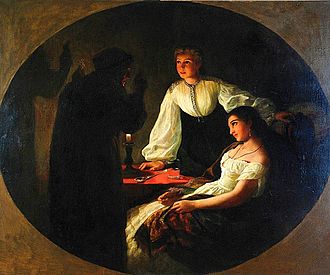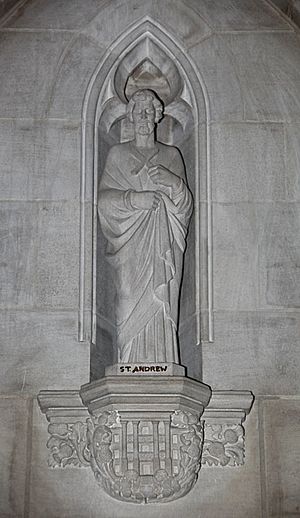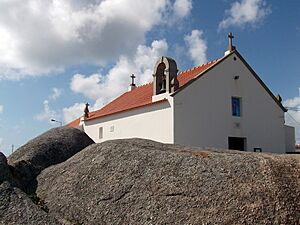Saint Andrew's Day facts for kids
Quick facts for kids Saint Andrew's Day |
|
|---|---|

Henryk Siemiradzki. St. Andrew's Night – Fortune-telling, 1867
|
|
| Observed by | Eastern Orthodox Church Roman Catholic Church (traditional holy day of precept) Anglican Communion Presbyterianism Patronal feast of Scotland |
| Type | Religious National (in Scotland and Romania) |
| Celebrations | Bank holiday (in Scotland, in Romania) |
| Date | 30 November (Western/Eastern Christianity) |
| Frequency | Annual |

Saint Andrew's Day is a special day that celebrates Andrew the Apostle. It is also known as the Feast of Saint Andrew or Andermas. People celebrate it every year on November 30. Saint Andrew was one of Jesus's first followers, called disciples. He is known for introducing his brother, Apostle Peter, to Jesus.
Contents
Celebrating Saint Andrew's Day
Saint Andrew's Day marks the start of a special time called Advent. This is a period of preparation before Christmas.
Saint Andrew's Day (Scots: Saunt Andra's Day, Scottish Gaelic: Là Naomh Anndrais) is the official national day of Scotland. It has also been a national holiday in Romania since 2015. Saint Andrew is considered the patron saint of many places. These include Cyprus, Scotland, Greece (especially the city of Patras), Romania, Russia, Ukraine, and Tenerife in Spain. He is also the patron saint of San Andres Island in Colombia and Saint Andrew in Barbados.
Scotland's Celebrations
People in Scotland have celebrated Saint Andrew as a national figure for a long time. Some believe this tradition started around the time of Malcolm III (1058–1093). While it has been celebrated for centuries, November 30 only recently became an official national holiday. However, it is still a normal working day for most people.
Bank Holiday in Scotland
In 2006, the Scottish Parliament passed a law to make Saint Andrew's Day an official bank holiday. If November 30 falls on a weekend, the holiday is moved to the next Monday. Even though it's a "bank holiday," banks usually stay open. Also, employers do not have to give their employees the day off. Schools usually remain open as well.
The University of St Andrews often gives its students the day off. However, this is not a strict rule.
The Saltire Flag
Saint Andrew's Day is an official flag day in Scotland. This means the flag of Scotland, known as the Saltire or Saint Andrew's Cross, is flown on all Scottish Government buildings. Before 2002, the Saltire was only flown on Saint Andrew's Day. Now, if a building has only one flagpole, the Union Flag is taken down and replaced with the Saltire for the day.
Some Scottish politicians feel that the Saltire should fly at Edinburgh Castle on this day. However, the British Army flies the Union Flag at the Castle. This is because it is an official British Army flag station.
Scottish Festivities
In Scotland and other countries with Scottish connections, Saint Andrew's Day is a time to celebrate Scottish culture. People enjoy traditional Scottish food and music. In Scotland, this day also marks the start of winter festivals. These include Saint Andrew's Day, Hogmanay (New Year's Eve), and Burns Night. The town of St Andrews and other Scottish cities often have week-long celebrations.
Barbados Celebrates
Saint Andrew's Day is also celebrated as the national day of Independence in Barbados. Saint Andrew is the patron saint of Barbados. He is featured in some Barbadian symbols. For example, the cross shape in the Barbadian Coat of Arms represents Saint Andrew.
Romanian Traditions
In Romania, there are old traditions linked to Saint Andrew's Day. Some of these traditions come from ancient Roman celebrations.
One belief is that during this night, wolves can eat as much as they want. It is also said that they can speak, but anyone who hears them will soon die. Early on Saint Andrew's Day, mothers gather branches from fruit trees like apple, pear, and cherry. They also collect rosebush branches. They make a small bunch of branches for each family member. If a person's bunch blooms by New Year's Day, they are believed to have good luck and health in the coming year.
A popular tradition for single girls on this night is about finding out who they will marry. They put a sprig of sweet basil under their pillow. If they dream that someone takes the plants, it means they will get married soon. Girls can also plant wheat in a dish and water it until New Year's Day. The healthier the wheat looks on that day, the better the year ahead is expected to be.
Saint Andrew's Eve Folklore
In parts of Ukraine, Germany, Poland, Russia, and Romania, the night before Saint Andrew's Day is special. People believe it's a good time for magic to reveal a young woman's future husband. It was also thought to be the start of a time when mythical creatures like vampires were active. This period would last until Saint George's Eve (April 22).
In Poland, this holiday is called Andrzejki. It is celebrated on the night of November 29-30. Traditionally, only young single girls took part. Today, both young men and women join in to learn about their future. A main activity involves pouring hot wax from a candle through a keyhole into cold water. The shape the wax makes is then "read" to predict the future.

In Romania, some young women put 41 grains of wheat under their pillow before sleeping. If they dream that someone tries to steal their grains, they believe they will marry next year. In other parts of the country, young women light an Easter candle. They take it to a fountain at midnight and ask Saint Andrew to show them their future husband.
In Póvoa de Varzim, a fishing town in northern Portugal, there is a place called Cape Santo André. Near the cape, there are small marks in a rock that people believe are Saint Andrew's footprints. Saint Andrew's Chapel is very old, mentioned in documents from 1546. It is a burial place for fishermen who drowned at sea. Fishermen also asked the saint for help with good catches. Single girls who wanted to get married would throw a small stone onto the chapel's roof, hoping it would stay there. People also associate this place with good luck charms. It was common to see groups of fishermen making a pilgrimage to the chapel on Saint Andrew's Eve. They believed Saint Andrew rescued the souls of those who drowned at sea.
Eton College Tradition
Saint Andrew's Day is one of the two biggest holidays celebrated at Eton College. The other major holiday is the Fourth of June.
See also
 In Spanish: Andrzejki para niños
In Spanish: Andrzejki para niños

